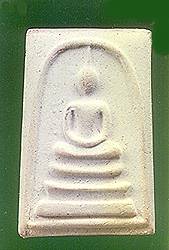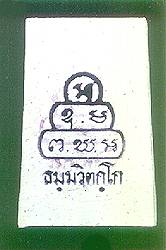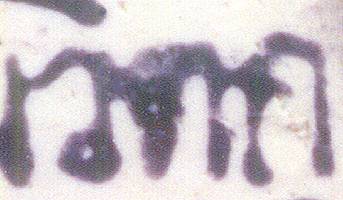| Thai amulets Created & Written by Lek Watruak |
|
 |
  |
| Front side | Deep
purple stamping ink on its back |
 |
 |
| Close-up view of the rubber stamp ink on the original authentic items, please notice the very fine residue layer of the ink. The ink was specifically mixed, not resembling to the general rubber stamp ink sold in the market. | |
| Authenticity Identification | |
| Dhan Chao Khun Nor's Somdej Lang YantMuek, B.E.2513 |
|
| The above pictures are original authentic Phra Somdej Lang YantMuek (Lang= back,
YantMuek= inking Yant), Dhan Chao Khun Nor, Wat Dhepsirin, B.E.2513. It's a general pop
amulet but there are a lot of fakes in the market--the fakes overwhelm the genuine. Here
are some cautions: 1.The fake amulets of this kind have been exported to neighbor countries. 2.DON'T BUY IT IF YOU COULD NOT ABSOLUTELY DIFFERENTIATE THE FAKES AND THE GENUINE, OR BUY IT FROM THE TRUSTABLE DEALERS ONLY. The fakes have "knocked out" a lot of collectors since the Chao Khun Nor's amulets became very well-known in B.E.2515. Up until now, still so many collectors buy fakes because they give identification priority to the amulet's relief print(Phim) and mass but lacking of intensively examining the rubber stamp ink. The most important criterion to identify this Phra Somdej is the rubber stamp ink on its back. The fake carry good craftmanship--its relief print (Phim) and mass resemble to the authentic item, but only one thing is significantly different-- the rubber stamp ink on the fake is purple with no residue layer. But for the original authentic item, the color of the ink is deep purple or deep blue with little red mixed, and there is a very fine residue layer on the dried ink which is not found on the rubber stamp ink of the fake. The ink used for stamping on genuine items was specifically mixed to protect their genuineness. The fake makers have tried to develop such the ink, but so far gain no success. Dhan Chao Khun Nor never made amulets by himself, but just blessed them. The major maker of amulets was Chao Khun Udomsarasophon, a former high-rank monk of Wat Dhepsirin. On Dec 5th, B.E.2513 was the greatest and final blessing ceremony, a lot of amulets from other temples were also brought in for blessing such as Wat Kao Bang Sai, Wat Silakhan, Wat Wiwek, Wat BodhiEn, Wat Saan Petch, Acharn Thong Jua's amulets, and Prok Jalay medal. Dhan Chao Khun NoraratRajManit or popularly called in short " Dhan Chao Khun Nor" was a close royal servant of King Rama VI. He had ordained a monk at Wat Dhepsirin in B.E.2468, and never left his monkhood until he passed away in early B.E.2514 at the age of 74. In his long years of monkhood, he ate only one vegetable and cereal meal a day and never stepped out of the temple even in the WWII period. In the war time, Bangkok railway main station just few Km away from the temple was intensively bombed by the allied force, but the bombs missed the target and hit the temple. Almost all monks left the temple for safty, but he was still living there. Dhan Chao Khun Nor was a strict Dhamma practicer. He practiced advanced Dhamma, devoted all his monkhood life to follow Lord Buddha's teachings, and never missed the morning and evening chant at Ubosoth until the end of his life. Dhan Chao Khun Nor could detect the thinking and mind of anyone who is speaking to him. He had pre-cognition mind power, and correctly foretold major events including his own death. This is so he well prepared everything before he left this world, by telling his nephew never offer him the food box anymore and also telling the next-room young monk that the day he did not go to chant means the day of his death. Then he went to sleep within a mosquito net, his two hands joined together on his chest--paying the last respect to Lord Buddha...he passed away with that beautiful posture on January 8, B.E.2514. VOCAB NOTE: Dhan = a leading word for revered monk |
|
| Thai amulets Home | |